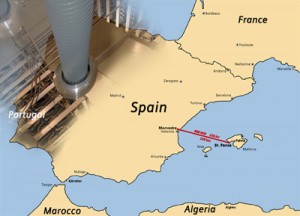
Back in October 2007 Siemens announced on its website that its Power Transmission and Distribution (PTD) would connect the resort island of Majorca to the power grid on the Spanish mainland for the first time.
The feat would be done through a 155 mile-long, 250kV HVDC submarine cable linking the island to Morvedre, near Valencia. The cable would allow power transmission of 400 MW at a DC transmission voltage of 250 kV from May 2011.
Majorca is a very popular holiday destination during the summer, when it is visited by hordes of northern European tourists. The electricity imports from the European power grid will cover the island’s peak load requirements. And what’s better, with a good share of renewable energy.
Now the project has been inaugurated, according to a statement Siemens released two days ago.
The amount of power the HVDC link will transmit to Majorca (400 MW) correspond to around 25 per cent of the island’s installed power plant capacity that serves 860,000 people who live there and ten million tourists who visit it annually. 35 per cent of the mainland power mix is based on alternative energy, whereas Majorca’s installed generation is largely based on gas, coal and oil. Compared with the construction of an additional new power plant the link to the mainland will in the future reduce annual CO2 emissions by as much as 1.2 million tons, or roughly halve emission, Siemens said.
According to Siemens Energy CEO, Michael Suess, the project is part of a larger trend in Europe to create a super grid. “With our HVDC technology renewables-based power can be transmitted over long distances with low lossesâ€, he said.
Siemens said that cables links longer than 80 kilometers are only possible with HVDC transmission technology. That is because for underground or submarine cables, hardly any electricity is delivered when AC lines are this length or longer, because the cable’s insulation serves as a capacitor and becomes charged, thereby absorbing the electricity.
The link laid to Mallorca comprises three single-piece submarine cables, which were supplied by the Italian cable specialist Prysmian together with the Norwegian cable manufacturer Nexans and laid at a depth of as much as 1485 meters on the Mediterranean seabed.
With overhead lines, HVDC reduces the transmission losses by between 30 and 50 percent. Given the same width of the cable run, 30 to 40 percent more energy can be transmitted than with conventional overhead lines carrying alternating current.
You should follow us here.





